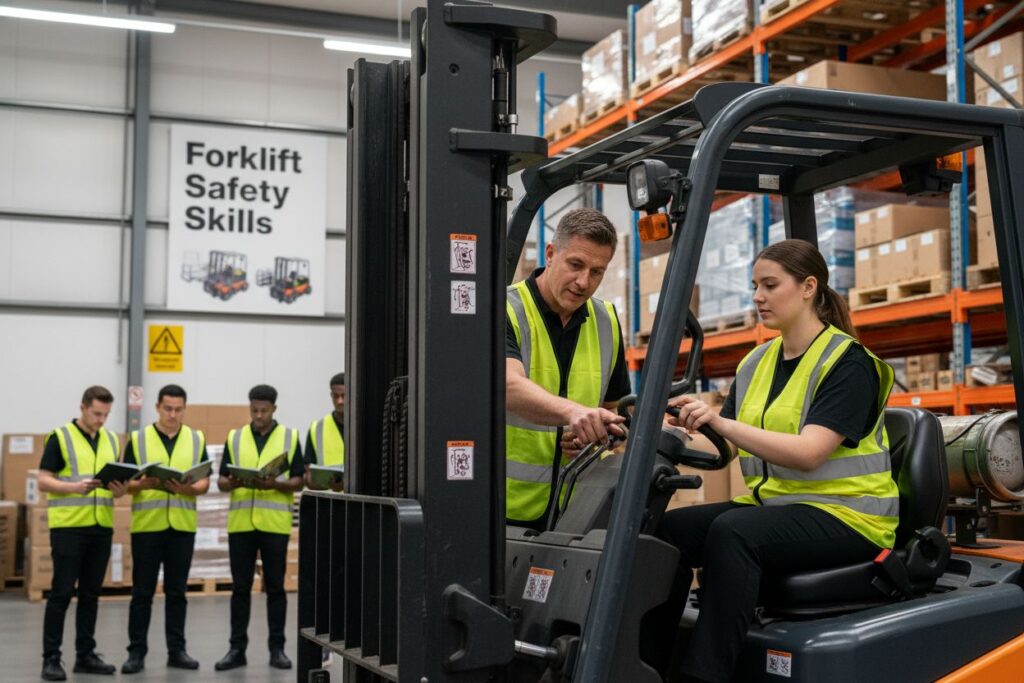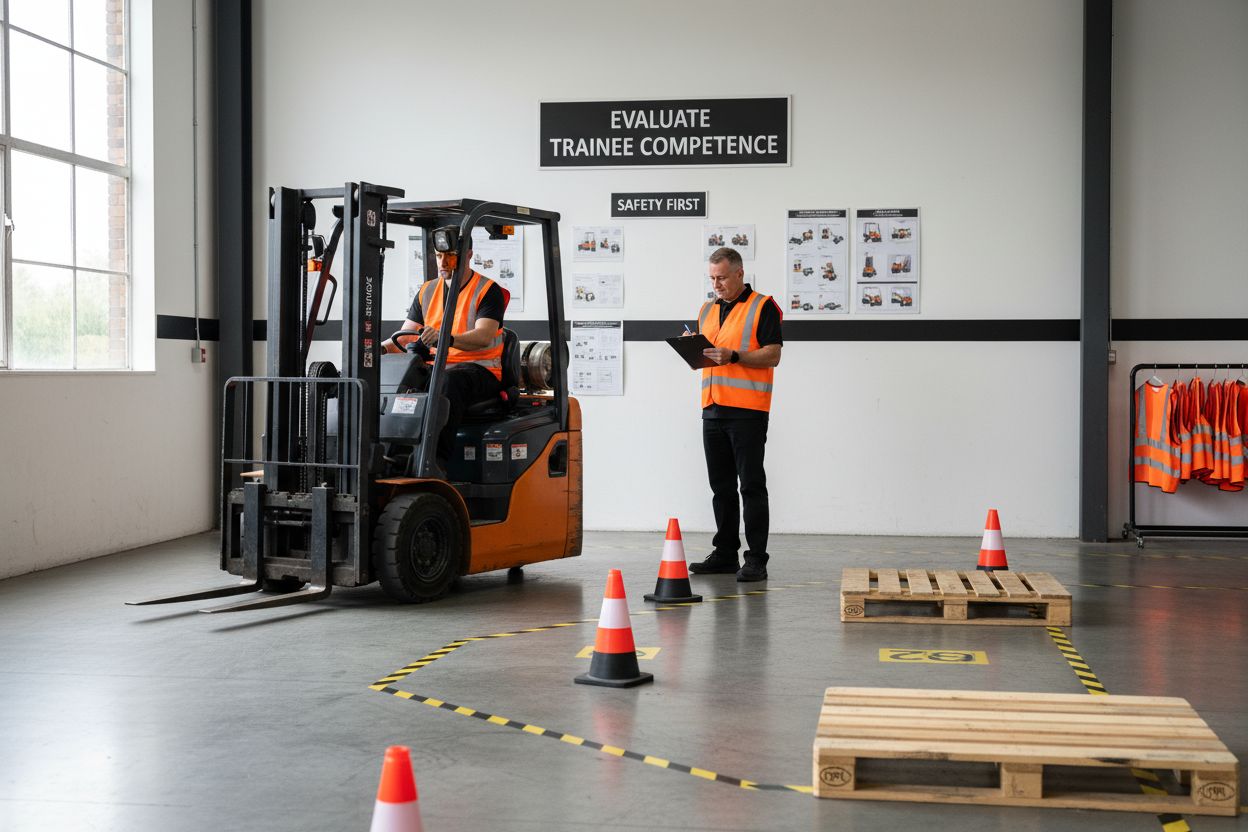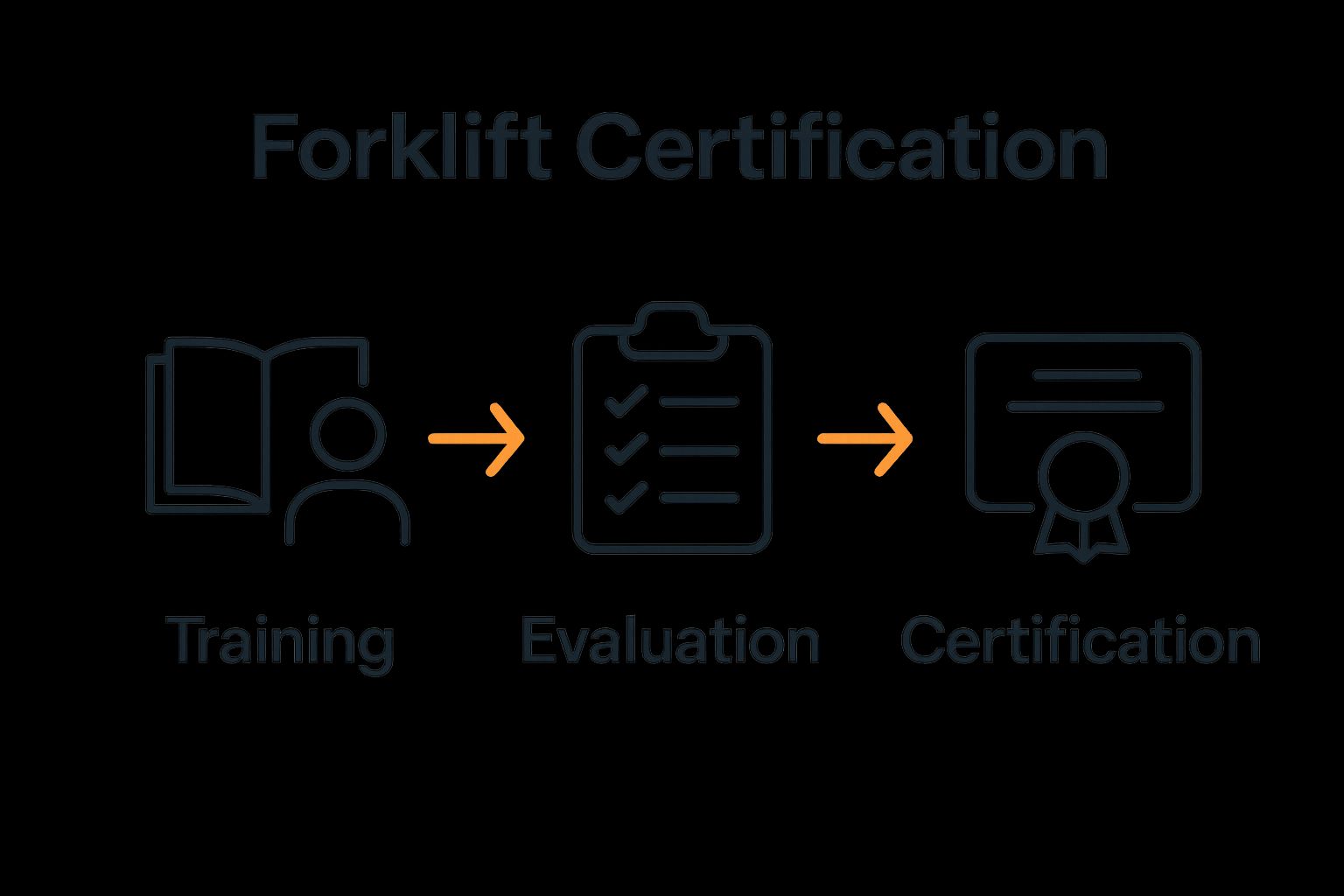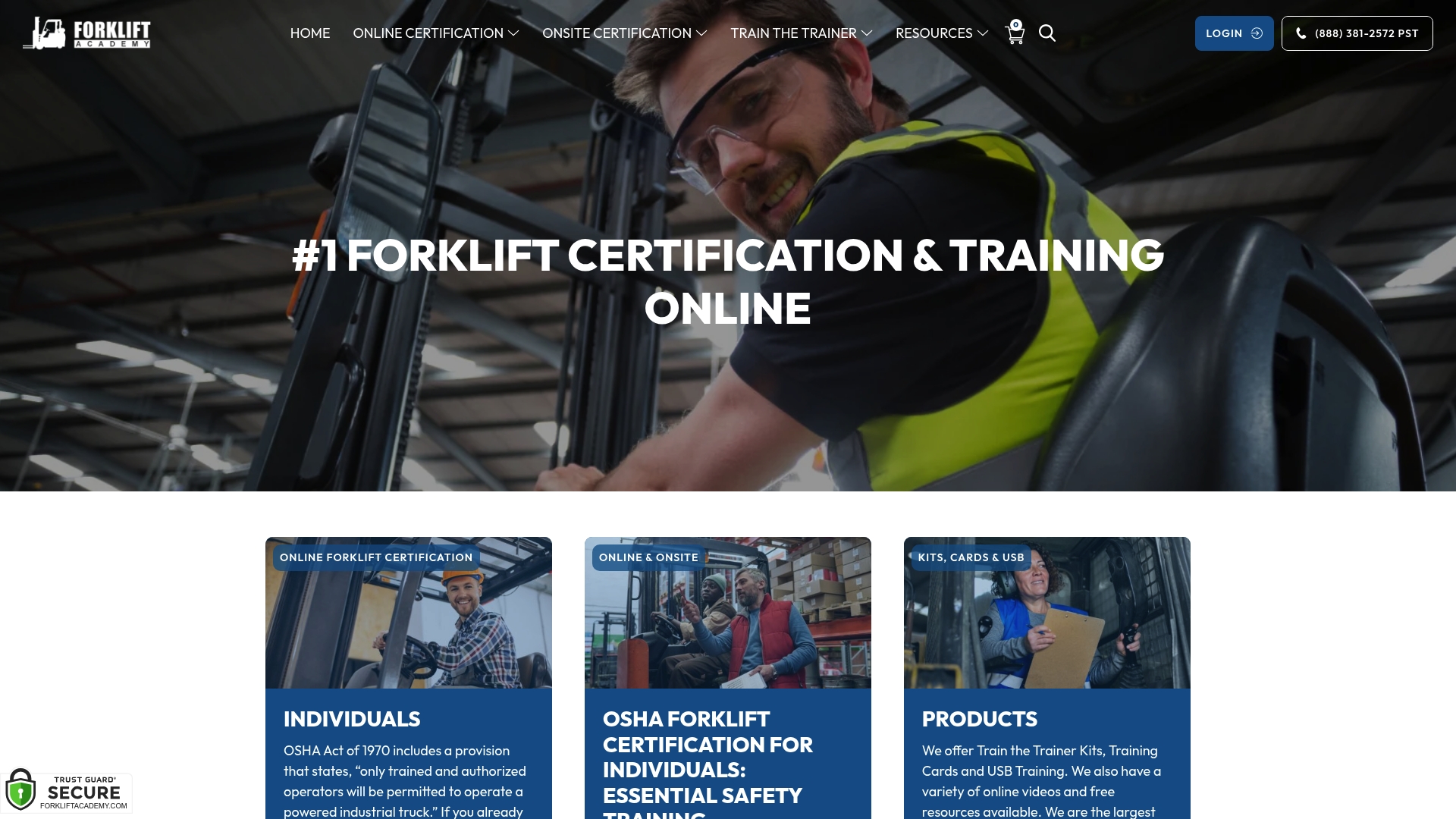
Organizing onsite forklift training might seem straightforward, just a matter of teaching operators how to handle heavy machinery. Yet what surprises most is that OSHA requires employers to match training exactly to the forklift models and hazards in their specific workplace. That means generic, one-size-fits-all lessons can leave operators underprepared and companies out of compliance.
| Key Point | Explanation |
|---|---|
| 1. Assess training needs thoroughly | Evaluate your workplace and equipment to tailor training programs effectively to specific operator challenges. |
| 2. Prepare comprehensive training materials | Develop manuals and visuals that cover operational principles and safety protocols, enhancing both knowledge and practical skills. |
| 3. Conduct hands-on training sessions | Integrate classroom instruction with practical demonstrations to ensure trainees understand safety applications in real scenarios. |
| 4. Implement rigorous trainee evaluations | Use written tests and practical assessments to measure both theoretical understanding and real-world operational skills effectively. |
| 5. Certify operators with detailed documentation | Ensure each operator receives a formal certification that includes their training details, promoting compliance and workplace safety. |
Successful onsite forklift training begins with a comprehensive needs assessment that establishes the foundation for safe and effective operator development. This critical first step involves systematically evaluating your workplace environment, equipment types, and specific operational requirements to design a targeted training approach.
Beginning the assessment requires a detailed examination of your current forklift fleet and workplace conditions. Employers must carefully analyze the specific powered industrial trucks used within their facility, considering factors such as truck type, capacity, operating terrain, and unique workplace hazards. OSHA regulations mandate a thorough evaluation to ensure training precisely matches the equipment and environmental challenges operators will encounter.
Your assessment should encompass multiple critical dimensions. Workplace mapping becomes essential documentation where you identify specific zones where forklifts operate including warehouse aisles, loading docks, storage areas, and potential high traffic intersections. Understanding these spatial dynamics helps trainers simulate realistic operational scenarios during instruction. Simultaneously, catalog the exact forklift models in your inventory tracking their individual specifications weight capacities and specialized features.
Operational complexity varies significantly across industries. Manufacturing environments differ dramatically from construction sites or distribution centers. Each setting presents unique operational challenges requiring nuanced training approaches. For instance, a warehouse with narrow storage racks demands different skill sets compared to an outdoor construction site with uneven terrain. Recognizing these contextual differences allows for precision in designing training curriculum.
To complete this assessment effectively, compile a comprehensive document that includes:
By meticulously documenting these elements, you create a robust foundation for developing a targeted onsite forklift training program that directly addresses your organization’s specific safety and operational requirements. If you want more details about customizing training programs, our additional resources can provide deeper insights into creating comprehensive training strategies.
Successful completion of this assessment phase means having a clear, documented understanding of your training needs that will guide every subsequent step in the forklift operator certification process.
Preparing comprehensive training materials and equipment represents a pivotal phase in developing an effective onsite forklift training program. This step transforms your initial assessment into actionable learning resources that will equip operators with the knowledge and skills necessary for safe equipment operation.
OSHA standards recommend developing a multifaceted training approach that combines theoretical instruction with hands-on practical experience. Successful preparation requires creating a strategic blend of educational materials that address both cognitive understanding and physical skill development. Begin by developing a detailed training manual that comprehensively covers forklift operational principles, safety protocols, workplace-specific hazards, and equipment-specific guidelines.
Your training materials should include a mix of visual and textual resources. Develop high-quality instructional guides with clear diagrams illustrating forklift mechanics, operational controls, and safety procedures. Incorporate scenario-based learning modules that simulate real-world workplace challenges, allowing trainees to understand how theoretical knowledge translates into practical application. Video demonstrations can be particularly effective in showcasing proper techniques for equipment inspection, maneuvering in tight spaces, and managing complex loading scenarios.
Physical equipment preparation is equally crucial. Ensure all training equipment is in pristine condition, properly maintained, and representative of the actual machinery operators will use. This means selecting training forklifts that match the specifications of your workplace fleet, complete with identical control configurations and operational characteristics. Set up a dedicated training area that mimics actual workplace conditions, including potential obstacles, narrow passages, and varied surface types that operators might encounter during regular duties.
To streamline your preparation, compile a comprehensive training kit that includes:
For organizations seeking additional guidance on developing robust training programs, our train-the-trainer resources offer in-depth strategies for creating effective instructional content.
Successful completion of this preparation phase means having a comprehensive, engaging, and practical training toolkit that transforms theoretical knowledge into actionable operational skills. Each material should be carefully designed to support safe, efficient forklift operation across diverse workplace environments.
To help you keep track of all necessary forklift training materials and their uses, here is a table summarizing each item mentioned in the preparation step.
| Training Material/Equipment | Description | Primary Purpose |
|---|---|---|
| Training Manual | Comprehensive written guide covering operational principles | Imparts essential knowledge and reference |
| Safety Procedure Documentation | Specific protocols and safety guidelines | Ensures regulatory and workplace safety compliance |
| Equipment Operation Guides | Instructions tailored to the machinery in use | Builds operator familiarity with controls |
| Visual Training Materials (Diagrams, Videos) | Visual aids like diagrams and demonstration videos | Helps visualize concepts and proper techniques |
| Scenario-Based Learning Modules | Simulated real-world workplace challenges | Prepares operators for specific hazards |
| Training Forklifts in Pristine Condition | Well-maintained equipment matching workplace specifications | Enables hands-on, real-world practice |
| Dedicated Training Area | Space set up to mimic actual workplace conditions | Provides a safe, realistic environment for practice |
Conducting comprehensive forklift training sessions transforms theoretical knowledge into practical operational skills through structured, interactive learning experiences. This critical phase bridges the gap between understanding safety principles and applying them effectively in real-world workplace scenarios.
OSHA guidelines emphasize the importance of integrating both classroom instruction and hands-on practical training. Begin by establishing a structured training environment that combines theoretical learning with immersive demonstration techniques. The initial classroom segment should focus on foundational knowledge, covering essential topics such as equipment mechanics, safety regulations, workplace hazard identification, and operational best practices.
Transition seamlessly from classroom instruction to practical demonstrations, creating an engaging learning experience that allows participants to observe and understand complex forklift operations. Skilled instructors should meticulously demonstrate proper equipment inspection procedures, highlighting critical safety checks including tire condition, hydraulic systems, control functionality, and overall mechanical integrity. Demonstrate precise maneuvering techniques, emphasizing smooth acceleration, controlled braking, and navigating challenging workplace configurations.
Practical training requires creating controlled scenarios that simulate real-world operational challenges. Set up obstacle courses and complex loading environments that test operators’ spatial awareness, precision control, and decision-making capabilities. Encourage trainees to perform actual forklift operations under close supervision, providing immediate constructive feedback and guidance. These hands-on experiences allow participants to develop muscle memory and confidence while understanding the nuanced skills required for safe forklift operation.
To ensure comprehensive skill development, structure your training sessions to include:
For organizations seeking advanced training methodologies, our train-the-trainer resources offer additional strategies for creating impactful learning experiences.
Successful completion of training sessions means participants demonstrate both theoretical understanding and practical proficiency in forklift operation, with clear evidence of their ability to perform tasks safely and efficiently across various workplace environments.
Evaluating trainee competence represents a critical checkpoint in the forklift training process, transforming learning into measurable operational capability. This comprehensive assessment ensures that operators not only understand theoretical principles but can demonstrably apply skills safely and efficiently in real-world workplace scenarios.
OSHA standards mandate a rigorous evaluation process that goes beyond simple written examinations. The assessment must comprehensively measure both theoretical knowledge and practical operational skills. Begin with a structured written examination that tests operators’ understanding of safety protocols, equipment mechanics, workplace hazard recognition, and regulatory compliance requirements.
Practical skills evaluation demands a systematic approach that simulates authentic workplace conditions. Develop a standardized performance assessment that includes precise maneuverability tests, load handling exercises, and scenario-based challenges that reveal an operator’s true competence. Instructors should observe trainees performing complex tasks such as navigating narrow aisles, executing precise turns, managing varying load weights, and demonstrating emergency response capabilities. Each performance should be meticulously scored against predetermined competency standards that reflect real-world operational requirements.
Comprehensive evaluation extends beyond individual performance metrics, incorporating critical safety awareness and decision-making capabilities. Assess how operators respond to unexpected challenges, their ability to maintain situational awareness, and their commitment to safety protocols. This holistic approach ensures that certification reflects not just technical skill, but a genuine understanding of workplace safety culture.
To ensure thorough and objective assessment, structure your evaluation process to include:
For organizations seeking advanced evaluation methodologies, our train-the-trainer certification program offers comprehensive strategies for developing robust assessment frameworks.
Successful completion of the evaluation phase means producing certified operators who demonstrate both the technical proficiency and safety consciousness required to operate forklifts effectively in complex workplace environments. Each assessment provides a clear, measurable indication of an operator’s readiness to perform their critical role safely and professionally.
Below is a table summarizing the main evaluation components and what each assesses, clarifying the comprehensive nature of forklift operator evaluations.
| Evaluation Component | What It Assesses | How It Is Conducted |
|---|---|---|
| Written Knowledge Examination | Understanding of safety, mechanics, hazard recognition | Structured written test |
| Practical Skills Performance Test | Ability to maneuver, handle loads, respond to scenarios | Supervised equipment operation |
| Safety Protocol Compliance | Adherence to safety regulations and site rules | Observation during practice |
| Operational Competency Scoring | Overall proficiency and readiness | Scored assessment against set standards |

Certifying forklift operators and maintaining rigorous documentation represents the critical final phase of the training process, transforming comprehensive training into legally recognized professional qualification. This step ensures that operators are officially recognized as competent and compliant with safety regulations, protecting both workplace safety and organizational liability.
OSHA regulations mandate precise documentation requirements for forklift operator certification. Develop a comprehensive certification document that includes specific details demonstrating the operator’s complete training journey. Each certification record should meticulously capture essential information including the operator’s full name, training dates, specific equipment types covered, trainer’s credentials, and comprehensive assessment results.
The certification process extends beyond simple paperwork. Create a robust tracking system that allows for ongoing monitoring of operator credentials, including scheduled refresher training and periodic skill reassessments. Implement a digital or physical filing system that enables quick verification of each operator’s current certification status. This systematic approach ensures continuous compliance and provides a clear audit trail for potential workplace safety inspections.

Certification represents more than a bureaucratic requirement it is a testament to an operator’s professional competence. Develop a formal certification presentation or recognition process that acknowledges the operator’s achievement while reinforcing the significance of their newly acquired skills. Consider creating a professional certification card or digital badge that operators can carry as proof of their qualification, which simultaneously serves as a motivation and a tangible representation of their professional development.
To ensure comprehensive certification documentation, prepare a standardized package that includes:
For organizations seeking additional guidance on maintaining certification standards, our OSHA certification guide offers comprehensive insights into compliance requirements.
Successful completion of the certification phase means creating a robust, legally compliant documentation system that validates each operator’s skills, protects organizational interests, and demonstrates a commitment to workplace safety and professional development.
Are you worried about whether your in-house forklift training truly prepares your operators for real-life risks? Many businesses struggle to bridge the gap between compliance, hands-on skills, and updated safety standards. Topics like equipment-specific training, tailored workplace assessments, and rigorous evaluation are essential for reducing accidents and ensuring OSHA compliance — as highlighted throughout this onsite forklift training guide. You need a partner who not only understands these challenges but delivers proven solutions that align with your operational demands. Learn more in our Forklift Safety Archives to see how the right approach makes a difference.

Trust Forkliftacademy.com for customized, OSHA-compliant onsite forklift and scissor lift training. Our programs address every step from assessment to certification, giving you peace of mind. Don’t wait until a safety audit or unplanned incident exposes gaps. Visit our Forklift License Archives to see how easy it can be for your team to meet the highest safety and documentation standards. Protect your staff and your reputation today — contact us to start building a safer, more compliant workplace.
The onsite forklift training process involves several critical steps: assessing training needs and requirements, preparing training materials and equipment, conducting training sessions and demonstrations, evaluating trainee competence and skills, and certifying operators while documenting compliance.
Customizing forklift training programs starts with assessing your specific operational needs, including the types of forklifts and the unique hazards present in your workplace. Documentation of the equipment inventory and workplace layout is essential to tailor the training curriculum effectively.
Forklift training materials should include detailed training manuals, safety procedure documentation, visual training aids, instructional guides, and scenario-based learning modules that effectively convey both theory and practical skills.
Trainee competence is evaluated through a combination of written examinations to test knowledge and practical skills evaluations that assess operators’ ability to perform tasks within simulated real-world conditions, ensuring they meet both technical standards and safety protocols.